Click on the button to go to :-
The Round the World Brick Trip
I've tripped over dozens of bricks from the UK, India, New Zealand and elsewhere, have a look at them all
along with a good group on Facebook for brick and brickworks enthusiasts here :-
Click on the thumbnail to enlarge a photo or map and sometimes read more about it.
Then click 'Full Size' on the toolbar to see it in all its glory.
Buckley
Buckley was the centre of Flint's brick industry with around 25 brickworks and home to some very well-known Welsh brands. A suberb book entitled 'Life in the Victorian brickworks of Flintshire and Denbighshire', written by Andrew Connolly, has a vast amount of information on the bricks and brickworks of these counties along with chapters on the brickmaking process itself. There are nearly 300 large pages of text, photos and maps and it is available from the usual bookseller websites.
The numbers in brackets in the listings are cross-references to those used by Andrew in his book.
Aston Hall Coal and Brick Co, Buckley (33) - SJ 2940 6605
A combined colliery and brickworks operation dating from the 1860s and lasting through the usual financial crises until 1913. Their trademark was 'Premier' and imprint 'Aston Flintshire'.

Aston Hall brickworks, 1869
|
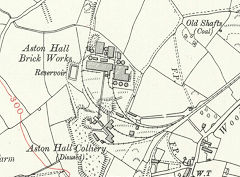
Aston Hall brickworks, 1909
|
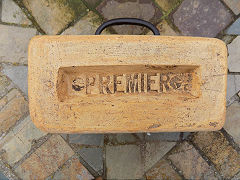
'Premier'
|
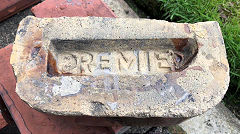
'Premier'
|
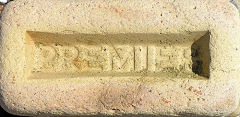
'Premier'
|
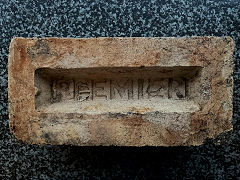
'Premier'
|
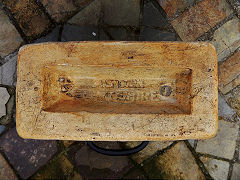
'Aston Flintshire'
|
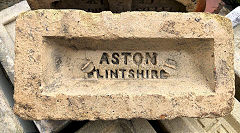
'Aston Flintshire'
|
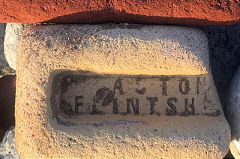
'Aston Flintshire'
|
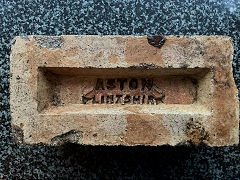
'Aston Flintshire'
|
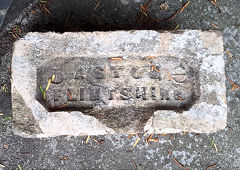
'Aston Flintshire'
|
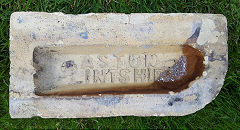
'Aston Flintshire'
|

'Aston Flintshire'
|
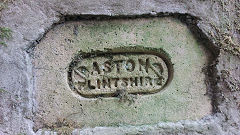
'Aston Flintshire'
|
|
|
Belmont (or Belmount), Buckley (40) - SJ 2797 6478
Starting life making drain pipes in the1850s, the Belmont (or Belmount) works became part of the Buckley Brick & Tile Co of the Brookhill works, adding three extra kilns. An odd accident happened in 1866 when the 105ft chimney collapsed. A new chimney was built but, when the works closed in 1912, this one was demolished.
Brookhill, Buckley (34) - SJ 2795 6561
Buckley Brick & Tile Co. Ltd was active from 1865 when it acquired Belmont and opened Brookhill. The company was sold to the Castle Firebrick Co in 1940, closed in 1961 and demolished in 1968. Their trademarks were 'Gibsonite' (named after Major Gibson , the Managing Director from 1866 to 1927), 'Metalline', 'Salamdine', 'FW' (flintshire White), 'BHB' (Brookhill Blue, the subject of a trade mark dispute with Davisons of Ewloe Barn, who used 'HBH') and 'BBB' (Best Buckley Blue). Bricks imprinted 'Brick & Tile' may well be from the Buckley Brick & Tile Co. However the phrase 'via Chester' was also used by the South Buckley Co.
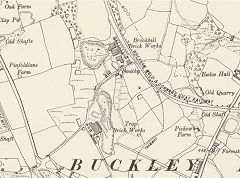
Brookhill Brickworks, 1900
|
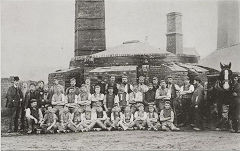
Brookhill Brickworks, 1894
|
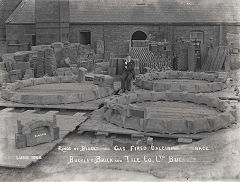
Buckley Brick & Tile Co, 1908
|
|
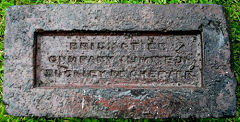
'Brick & Tile Co Limited Buckley Nr Chester'
|
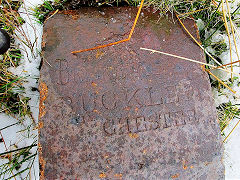
'The Brick & Tile Co Limited Buckley via Chester'
|
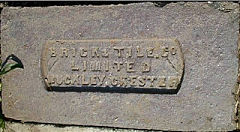
'Brick & Tile Co Limited Buckley Chester'
|
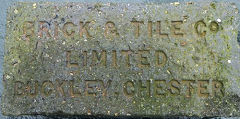
'Brick & Tile Co Limited Buckley Chester'
|
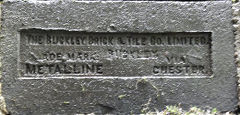
'The Buckley Brick & Tile Co Limited Buckley via Chester Trade Mark Metalline'
|
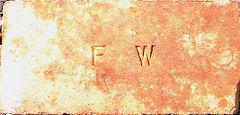
'FW'
|
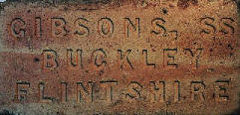
'Gibsons SS Buckley Flintshire'
|
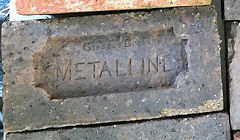
'Gibsons Buckley Metalline'
|
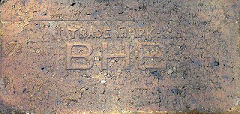
'Trade Mark BHB'
|
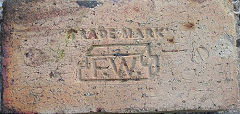
'Trade Mark FW'
|
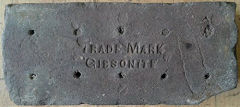
'Trade Mark Gibsonite'
|
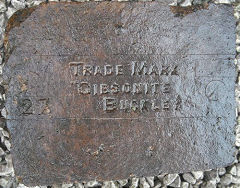
'Trade Mark Gibsonite Buckley'
|
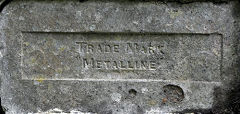
'Trade Mark Metalline'
|
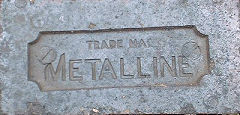
'Trade Mark Metalline'
|
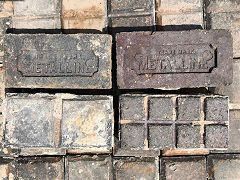
'Trade Mark Metalline' pavers
|
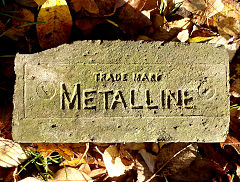
'Trade Mark Metalline'
|
Buckley Common, Buckley (46) - SJ 2820 6442, SJ 2832 6430
John Lewis owned two small brickworks on what is now Buckley Common
Buckley Junction, Buckley (52) - SJ 2935 6350
Buckley Junction brickworks, established in 1911 by 'Jones and Lamb Brickworks', it became the 'Buckley Junction Metallic Brick Co Ltd' in 1919, The company failed in 1956 and was taken over by the Castle Firebrick Co. The works soon closed in 1959 with operations transferred to Lane End brickworks. Their well-known trademarks were 'Jacobean' and 'City' and these were manufactured at the Lane End brickworks after the closure. 'BCM' stands for 'British Commercial Monomarks', a marketing organisation for a number of independent brick and other companies. A little to the East, the 1839 Tithe map shows a brickfield for Robert and John Jones at SJ 2959 6331.

Buckley Junction brickworks, 1948
|
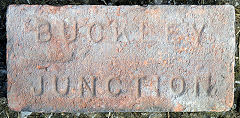
'Buckley Junction'
|
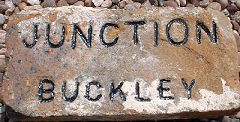
'Junction Buckley'
|
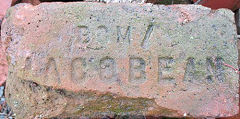
'B C M Jacobean'
|

'Jacobean'
|
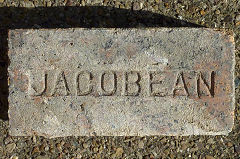
'Jacobean'
|
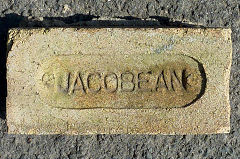
'Jacobean'
|

'Jacobean'
|

'Jacobean'
|
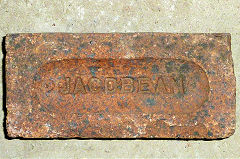
'Jacobean'
|
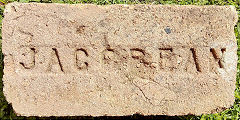
'Jacobean'
|
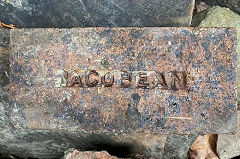
'Jacobean'
|
This brick is dated 20.04.90 so was made at the Lane End Brickworks
|

'Jacobean 200490'
|
|
|
Castle Brick Co, Buckley (29) - SJ 2749 6682
The Castle Brick Co opened in 1866, becoming the Castle Firebrick and Coal Co in 1875. It became part of John Summers Ltd of Shotton steelworks in 1916, passing to the British Steel Corportion in 1971. They sold it to the 'Butterly Brick Co in 1972 but it closed in 1976. They used a logo of a castle as their trademark. Bricks marked 'CBC' may either indicate the 'Castle Brick Co' or the 'Cardiff Brick Co', Glamorgan. The claypits were served by a narrow-gauge railway and a fleet of small steam locomotives.
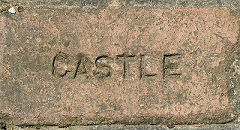
'Castle' from Castle Brick Co
|
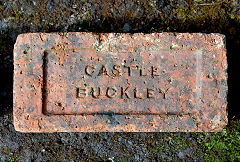
'Castle Buckley'
|
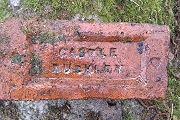
'Castle Buckley'
|

'Castle Buckley'
|

'Castle Brick Co'
|
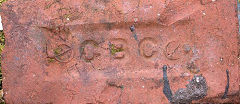
'CBC'
|
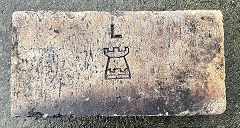
'L' and 'Castle' logo
|
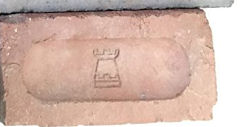
'Castle' logo from Castle Brick Co
|
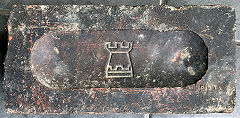
'Castle' logo from Castle Brick Co
|
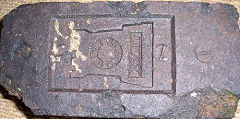
'Castle' logo from Castle Brick Co
|
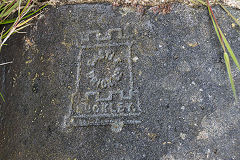
'Castle Brick Co Buckley'
|
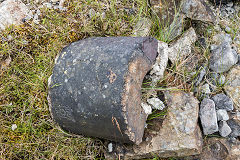
'Castle Brick Co Buckley'
|
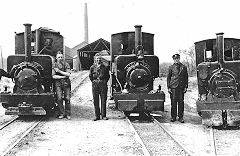
A line-up of the claypit locos in 1953
|
|
|
|
Castle Brick Co, New Works, Elm Colliery, Buckley (30) - SJ 2720 6640
Elm Colliery dates from 1876 and seems to have carried out some brickmaking at the site. In 1920 the Castle Fireclay Co bought the colliery which possibly only lasted to the 1930s. However they built a new brickworks on the property making housebricks. until the works closed in 1970. The claypits were those of the main site.
Ewloe Barn brickworks, Buckley (32) - SJ 2778 6615
Charles Davison & Co Ltd
Charles Davison & Co Ltd were one of the biggest brick manufacturers in Wales with their 'Adamantine', 'Alumantine', 'Obsidianite', 'HBH' and Hysilyn' brands. 'Adamantine' possibly holds the record for imprinting no less than 77 letters on one brick! They specialised in refractory and acid resistant bricks at their Ewloe Barn Brick and Tile Works and Old Ewloe works, active from 1933 to 1951. The company merged with General Refractories Ltd, and then taken over by the firm of G. R. Stein Ltd. The site closed in 1967. At some time it appears that 'Adamantine' bricks were also produced in Scotland, possibly after the General refractories merger. The Ewloe area is between Buckley and Hawarden, so both towns appear on their imprints. Davisons also owned the 'Old Ewloe' brickworks.
'Adamantine' brand
Adamantine was a dense 25% alumina firebrick.
Bricks imprinted 'Adamantine Clinker Regd' are not from this brickworks. They were made by Williamson Cliff Ltd of Little Bytham, Lincs
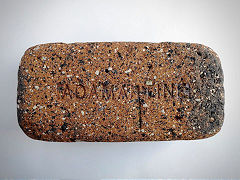
'Adamantine'
|
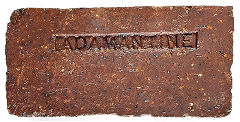
'Adamantine'
|
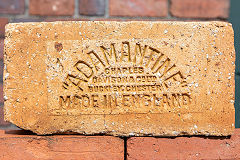
'Adamantine Made in England etc'
|
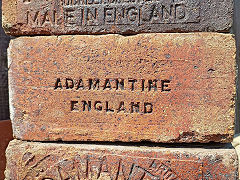
'Adamantine England'
|

'Hard Durable Adamantine etc.'
|
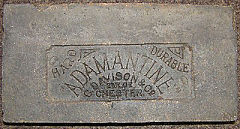
'Hard Durable Adamantine etc.'
|
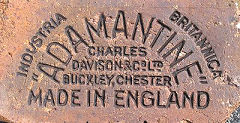
'Industria Britannica Adamantine etc.'
|
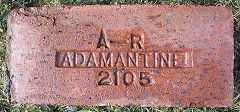
'A-R Adamantine 2105'
|
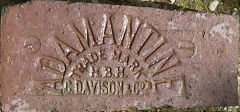
'Adamantine Trade Mark HBH etc.'
|
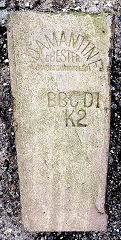
'Adamantine Chester BBC D2 K2 etc.'
|
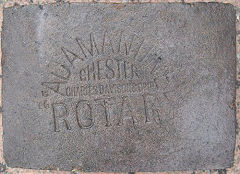
'Adamantine Chester Rotary etc.'
|
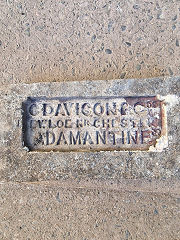
'C Davison & Co Ewloe Nr Chester Adamantine'
|
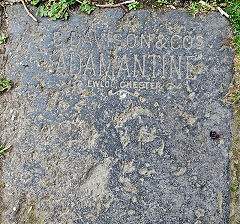
'C Davison & Co's Adamantine'
|
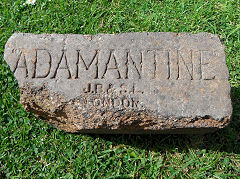
'Adamantine JB&SL London'
|
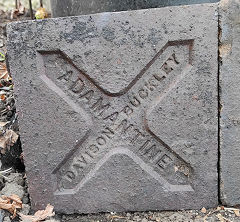
'Adamantine Davison Buckley'
|
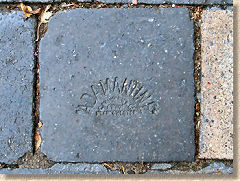
'Adamantine' paver
|
'Alumantine' brand
Alumantine blocks came in 4 types:- Alumantine 70/72 - Fired high alumina, Alumantine 60/65 – Fired high alumina, Alumantine 43/45 – Fired high alumina and Alumantine 40/43 – Fired high alumina.
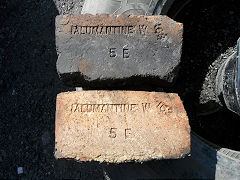
'Alumantine W 5E'
|

'Alumantine 70%'
|
|
'C Davison' brand
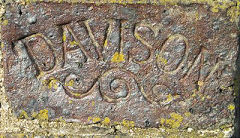
'Davison'
|
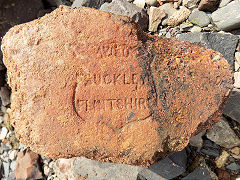
'C Davison Buckley Flintshire'
|
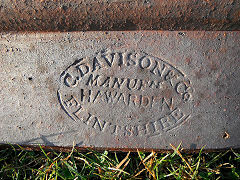
'C Davison & Co Manufrs Hawarden Flintshire'
|
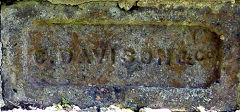
'C Davison & Co'
|

'C Davison Flintshire'
|
|
'Hysilyn' brand
Hysilyn was a dense 28% alumina firebrick
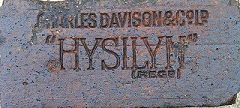
'Hysilyn Regd'
|
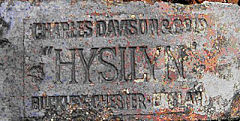
'Hysilyn Buckley Chester England'
|
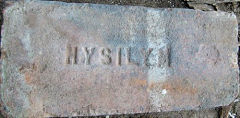
'Hysilyn'
|
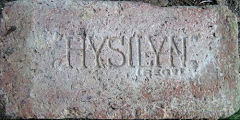
'Hysilyn Regd'
|
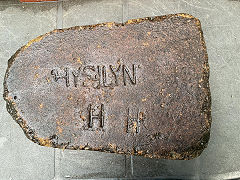
'Hysilyn H H'
|
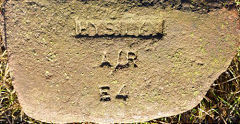
'Hysilyn Air E4'
|
'Obsidianite' brand
Obsidianite was an acid-resisting brick.
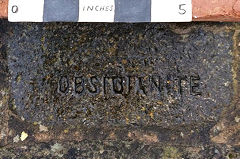
'Obsidianite'
|
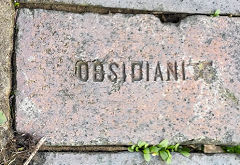
'Obsidianite'
|
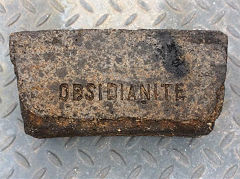
'Obsidianite'
|
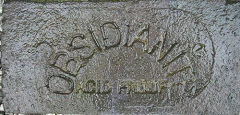
'Obsidianite Acid Proof'
|
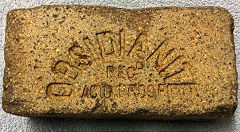
'Obsidianite Regd Acid Proof'
|
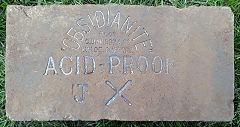
'Obsidianite Acid Proof JX etc.
|
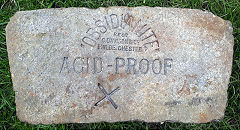
'Obsidianite Acid Proof X etc.'
|
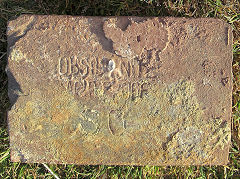
'Obsidianite Acid Proof SO'
|

'Obsidianite Acid Proof' pipe
|

Restored Pyrite kilns, Widnes
|
|
|
Ewloe Place brickworks (39) - SJ 2801 6487
Jonathan Catherall, a member of the Catherall family of Trap Brickworks (q.v.), set up Ewloe Place brickworks in 1793. There's little known about it but it appears to have closed c1914 with the chimney being demolished in 1917.
Ewloe Wood brickworks, Buckley (31) - SJ 2767 6634
Edward Parry opened his brickworks at Ewloe Wood in 1863 becoming 'E Parry & Sons Ltd' in 1902 using the trademarks 'Dragon' and 'Acidio'. In 1944 their neighbours, the Castle Firebrick Co Ltd, took over the company and it appears to have ceased production in 1962 by when the clayholes of Parrys and Castle had merged.
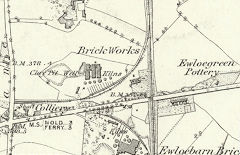
Ewloe Wood brickworks, 1869
|
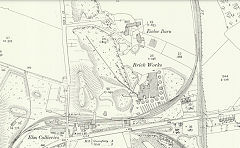
Ewloe Wood brickworks, 1909
|
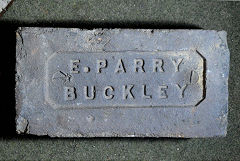
'E Parry Buckley'
|
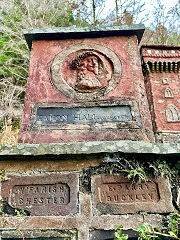
'E Parry Buckley'
|
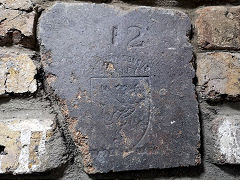
'E Parry & Sons Ld Buckley'
|
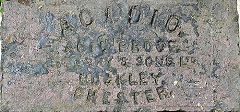
'Acidio Regd E Parry & Sons Ltd'
|
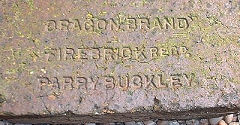
'Dragon Brand Firebrick Regd'
|
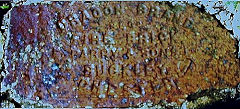
'Dragon Brand Regd Firebrick'
|
Etna Brick & Tile Co, Buckley (37) - SJ 2863 6529
The Etna brickworks was owned by George Watkinson and Sons who owned a number of collieries and brickworks in the area in the 19th and 20th centuries. Brickfields are shown on the 1839 Tithe maps which became a recognisable brickworks by 1854 as the 'Ewloe Brick & Tile Works'. The works are shown as 'disused' in 1948 but survived in a ruinous state until 1976 but was cleared in 1979 and the claypit filled.
The Globe Fire Clay Works, Buckley (36) - SJ 2865 6530
The Globe Fire Clay Works, trademark 'Fort', on the other side of the railway line from Etna Brickworks, was working from 1878 to 1912, when the claypit was becoming exhausted. It's still shown on the 1938 map but as 'disused'. The site had been cleared by 1948 but the claypit still survives.
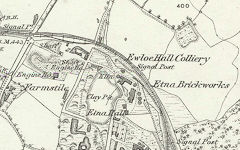
Etna Brickworks, Buckley,1869
|
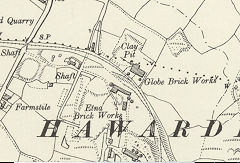
Etna and Globe Brickworks, 1898
|
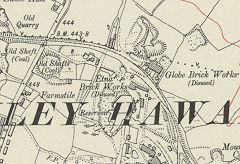
Etna and Globe Brickworks, 1938
|
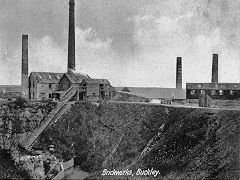
Etna Brickworks, Buckley
|
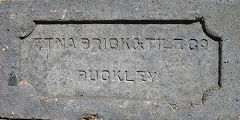
'Etna Brick & Tile Co Buckley'
|
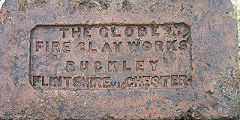
'The Globe Fire Clay Works Buckley Flintshire via Chester'
|
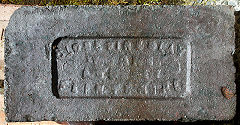
'The Globe Fire Clay Works Buckley Flintshire'
|
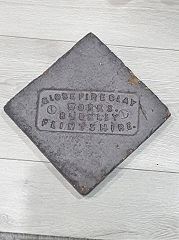
'The Globe Fire Clay Works Buckley Flintshire' tile
|

'Fort'
|
Knowle Hill brickworks (New Mount), Buckley (47) - SJ 2881 6437
Knowle Hill brickworks, oftern referred to as New Mount brickworks, was opened by Hancock and Co in c1865, probaly to secure the land, and almost immediately closed. It re-opened in the 1890s but is shown as 'disused' on the 1900 and 1912 OS maps.The chimney was demolished in 1941.
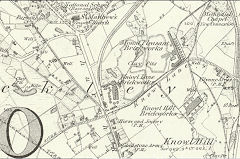
Knowle Hill brickworks, 1869
|
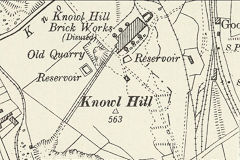
Knowle Hill brickworks, 1897
|
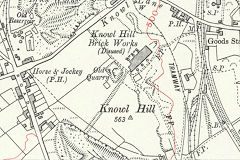
Knowle Hill brickworks, 1909
|
Knowle Lane brickworks, Buckley (45) - SJ 2855 6445
R Ashton & Co were an old-established brickworks, working from c1790 to 1902. Richard Ashton bought the works in 1841 as the 'Nowland End Brickworks' and set about updating it and in 1862 it was connected to the Buckley Railway. Richard Ashton died in 1867 and the works was leased to the Prince brothers, retaining the Ashton brand.By 1902 the works had closed and was in a ruinous condition. The works was then used a s a railway wagon repair yard, the kilns still being shown on OS maps up to 1938.

Knowle Lane brickworks, 1869
|
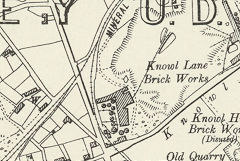
Knowle Lane brickworks, 1897
|
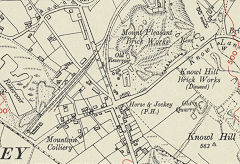
Knowle Lane brickworks, 1938
|

Knowle Hill claypit, c2019
|

'R Ashton & Co Buckley Flintshire'
|
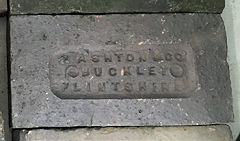
'R Ashton & Co Buckley Flintshire'
|
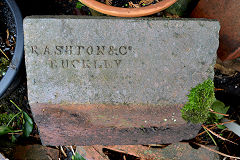
'R Ashton & Co Buckley'
|
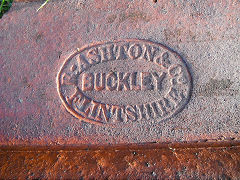
'R Ashton & Co Buckley'
|
Lane End brickworks, Buckley (48) - SJ 2879 6394
Hancock and Co opened the Lane End brickworks in 1792 by William Hancock, the son of Jonathan Catherall's daughter. There was much trouble in the 1890s when the Lane End Colliery encroached on the clay grounds, Hancocks had to go to court, they won and the colliery closed in 1903. Hancocks sold the works to Fred Jones of the Wepre Hall brickworks, Shotton. It became part of the Castle Firebrick Co in 1956 who modernised the whole works. Butterley and Hanson were last owners from 1971 until the works closed as late as 2004, the last brickworks in Buckley. Lane End took over the production of Buckley Junction brickworks in 1959 and continued using their 'Jacobean' and 'City' trademarks, which are illustrated under the Buckley Junction entry.
One unique feature of the Lane End bickworks was its tramway. The tramway was originally part of the 'Aston Tramway' running to the River Dee in the early 1800s. It ran through a tunnel on leaving the brickworks which had a signal on top of the hill to show the line was clear. When the railway arrived in 1862 the tramway became little used so a wharf was built on the railway and the tramway re-vitalised, lasting until the 1940s. The 'new' tramway had two very unusual features, one was the track and the other the unloading arrangements. The track was traditional bullhead rail but laid on its side so that plain unflanged wagon wheels ran in the groove. Even points were made in this fashion. This could only be done in straight runs so old tramplates were used for changes of direction. At the wharf the tramway wagons were loaded straight into railway wagons using a traverser system set at a level between the tramway and the railway. Each railway wagon could take 6 tramway wagons. Many thanks to Phil Pritchard for the photos and information on the tramway.
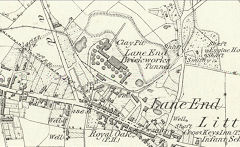
Lane End brickworks, 1869
|

Lane End brickworks, 1898
|
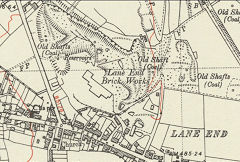
Lane End brickworks, 1948
|

Lane End brickworks
|
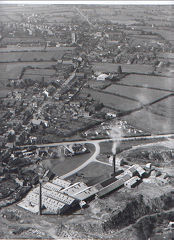
Lane End brickworks, 1962
|
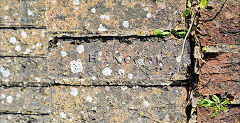
'Hancock'
|
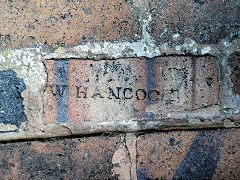
'W Hancock'
|
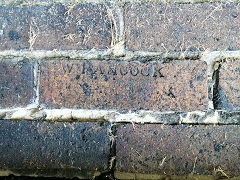
'W Hancock'
|
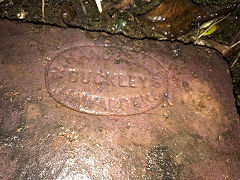
'W Hancock & Co Buckley Hawarden'
|
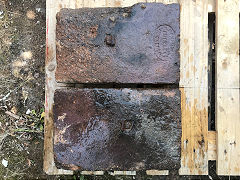
'W Hancock & Co Buckley Hawarden'
|
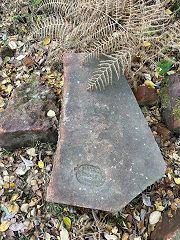
'W Hancock & Co Buckley Hawarden'
|
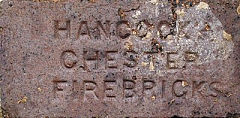
'Hancock Chester Firebricks'
|
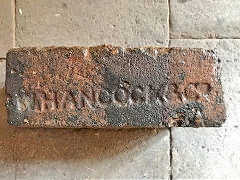
'W Hancock & Co'
|
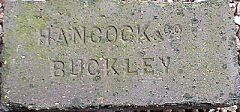
'Hancock & Co Buckley'
|
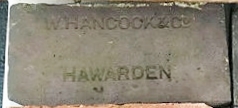
'W Hancock & Co Hawarden'
|
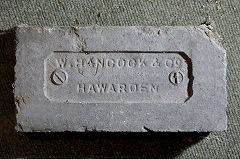
'W Hancock & Co Hawarden'
|

'W Hancock & Co Hawarden'
|
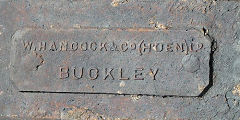
'W Hancock & Co (H'den) Ld Buckley'
|
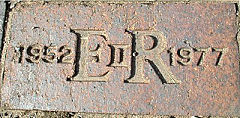
'1952 EIIR 1977'
|
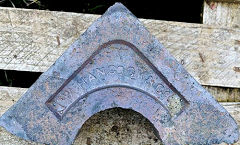
'W Hancock & Co'
|

'Butterley Lane End'
|
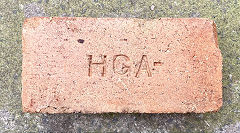
'HGA'
|
|
|
Hancocks Brickworks tramway
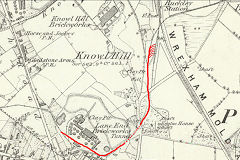
Hancocks Wharf tramway, 1869
|
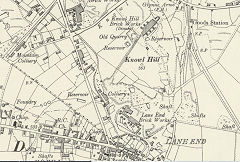
Hancocks Wharf tramway, 1897
|

Hancocks Wharf tramway, 1909
|
|
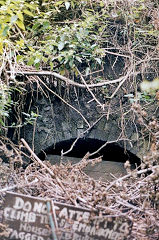
Knowle Hill tunnel portal
|
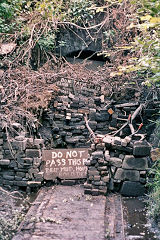
Knowle Hill tunnel portal
|
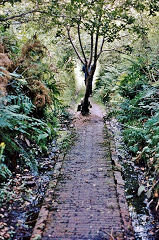
Cutting approaching the tunnel
|
|
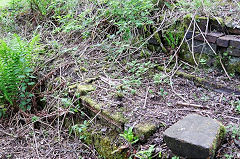
Hancocks Wharf track
|
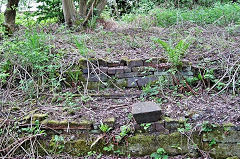
Hancocks Wharf track
|
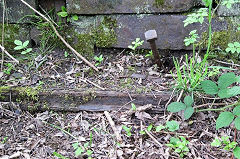
Hancocks Wharf track close-up
|
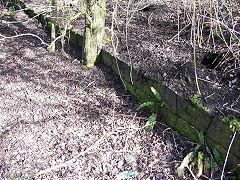
Hancocks Wharf track close-up
|

Trackwork below the tunnel
|
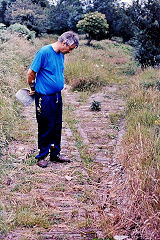
Pointwork with a moving blade
|
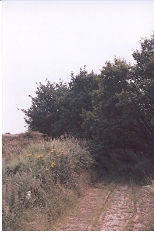
Hancocks Wharf
|
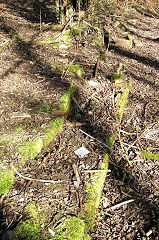
Hancocks Wharf
|

Hancocks Wharf
|
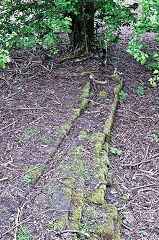
Hancocks Wharf
|
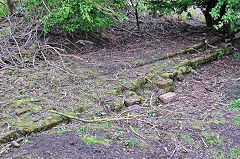
Hancocks Wharf
|
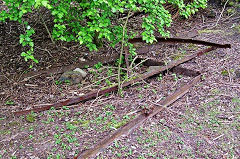
Hancocks Wharf tramway rail
|
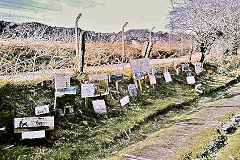
Hancocks Wharf notices
|
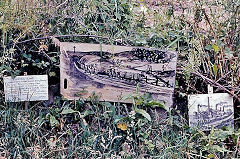
Painting of the tunnel
|
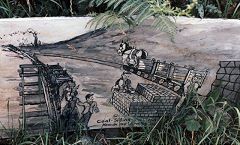
Painting of the wharf
|
|
Mount Pleasant brickworks, Buckley (44) - SJ 2875 6455
The 1839 Tithe map shows a 'brickground' here occupied by H L Rigby, a partner of W Hancock of the Lane End brickworks, who seems to have been very involved with it. It was shown as 'old brickworks' in a 1912 rates book. It closed in 1931 and the chimney demolished in 1938.

Mount Pleasant brickworks, 1869
|

Mount Pleasant brickworks, 1897
|
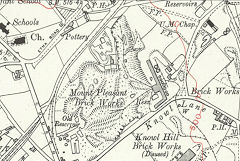
Mount Pleasant brickworks, 1909
|
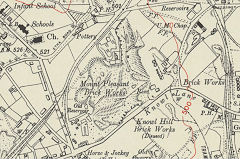
Mount Pleasant brickworks, 1938
|
Mount Pleasant, Standard brickworks, Buckley (41) - SJ 2894 6492
An offshoot of the Mount Pleasant Colliery by John Bates Gregory, opened in 1886, it became the 'Standard Buff and Glazed Brick Co' by 1906 and the 'Standard Brick abd Terra-cotta Co by 1910. The works had become a pipe works in the 1940s and closed in 1969. Bricks were also imprinted 'Standard Buckley'.
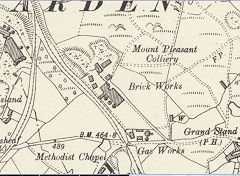
Standard brickworks, 1897
|
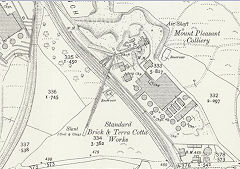
Standard brickworks, 1909
|

Standard brickworks, Buckley, Flintshire
|
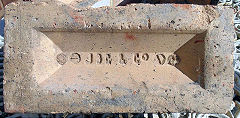
'J B G & Co'
|

'Standard'
|

'Standard Buckley'
|
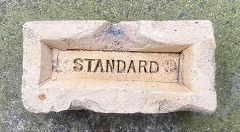
'Standard' with 'Buckley Flintshire'
|
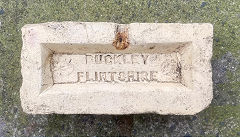
'Buckley Flintshire' with 'Standard'
|
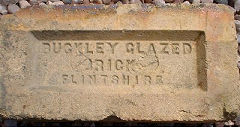
'Buckley Glazed Bricks Flintshire'
|
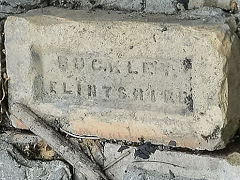
'Buckley Flintshire'
|
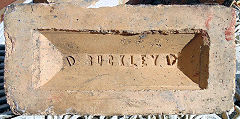
'Buckley'
|
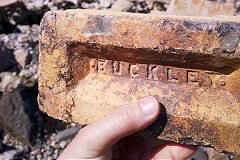
'Buckley'
|
Padeswood Hall Colliery, Buckley (53) - SJ 2926 6244
The 'Padeswood Hall Colliery Co' was inaugurated in 1875 along with the 'Padeswood United Cannel Coal & Iron Co', either of which could have made the bricks advertised for sale in 1877. In 1897 the 'Padeswood Buckley Brick & Coal Co' came into being but promptly collapsed with all property being auctiond off in 1902. They had grand plans for a new brickworks but nothing developed.
Old Ewloe brickworks, Buckley (38) - SJ 2870 6503
The Old Ewloe brickworks commenced in 1818 by 'Williamson & Co' partnered by John Smalley as 'Smalley & Co'. It passed briefly to Walter Pownall in 1842 and acquired in 1844 by Charles Davison. The company merged with General Refractories Ltd, and then taken over by the firm of G. R. Stein Ltd. Under Steins, the works made concrete and stoneware products until it closed in 1979. The site is now a football ground. For examples of Davisons output see 'Ewloe Barn' brickworks.
The stoneware paving block shown here is probably a late product of this works under Steins management but its a complete contradiction. It is stamped 'J C E' for 'J C Edwards' of Cefnmawr, Denbighshire, who closed in 1959, and 'Adamantine' which is a Davison brand.
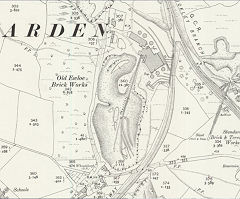
Old Ewloe brickworks.1909
|
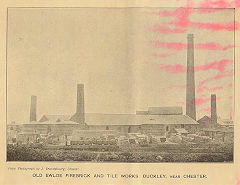
Old Ewloe brickworks
|
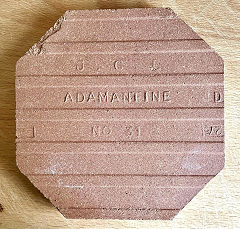
'JCE Adamantine No 31
|
Pentrobin, Buckley (49) - SJ 2902 6398
The small Pentrobin Colliery stood here from around 1860 who were employing a brickmaker in 1884. The colliery and its brickworks had gone by 1899.
Sandycroft, Buckley (42) - SJ 2895 6472
A small brickworks was set up in 1879 or thereabouts by Charles Jones. It was still working in 1905 but there were two disused kilns here in 1914.
Sandycroft, Buckley (43) - SJ 2906 6453
Sandycroft Colliery and Brickworks were working in c1860 under a number of owners including Samuel P Ward & Co (1876) and Drury & Co, until closure in the 1960s. Bricks marked 'W' may be from Wards ownership.
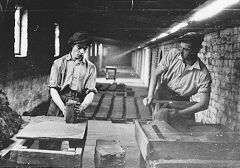
Workers at the Drury brickworks
|
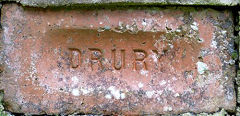
'Drury'
|
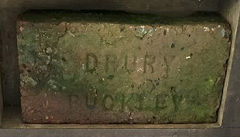
'Drury Buckley'
|
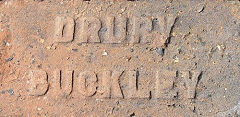
'Drury Buckley'
|
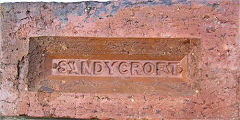
'Sandycroft'
|
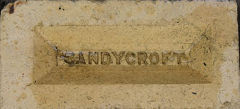
'Sandycroft'
|
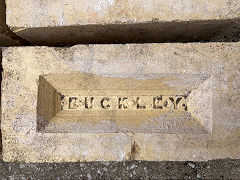
'Buckley' on the reverse
|
|
South Buckley Colliery and Brickworks, Buckley (50) - SJ 2738 6441
Beginning business as the 'South Buckley Coal and Firebrick Co' in 1866, it was acquired by David Evans of Liverpool in 1880. At the same time he had bought the 'North Buckley Colliery and firebrick Co', and amalgamated the two as the 'North and South Buckley Colliery, Brick and Tile Co Ltd'. The South Buckley site prospered and changed name in c1890 to 'South Buckley Rock Brick Co'. The clay came by a tramway from the North Buckley site, confusingly now known as West Buckley Colliery. For some reason, possibly a clay shortage, the brickworks closed in 1914 and was soon dismantled.

South Buckley brickworks, 1897
|
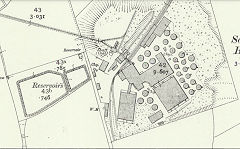
South Buckley brickworks, 1912
|
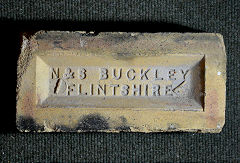
'N & S Buckley Flintshire'
|
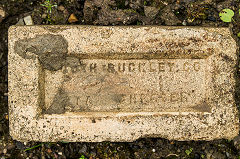
'South Buckley Co Via Chester'
|
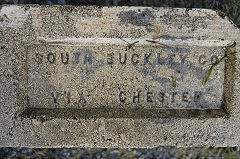
'South Buckley Co Via Chester'
|
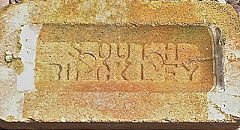
'South Buckley'
|
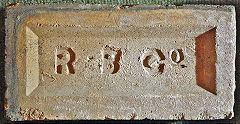
'R B Co'
|

'Rock'
|
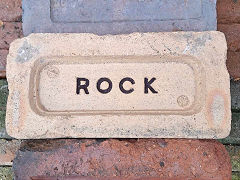
'Rock'
|
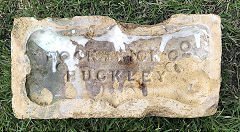
'Rock Brick Co Buckley Flintshire'
|
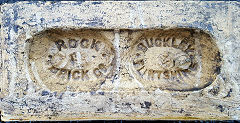
'Rock Brick Co Buckley Flintshire'
|
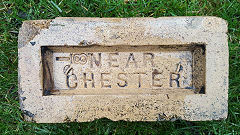
'Near Chester'
|
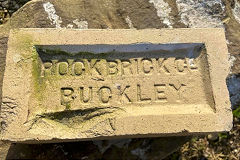
'Rock Brick Co Buckley'
|
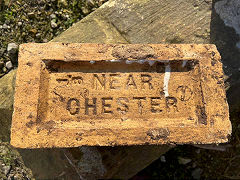
'Near Chester'
|
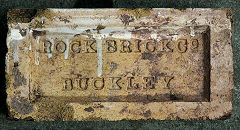
'Rock Brick Co Buckley'
|
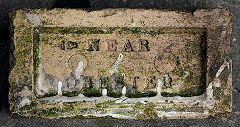
'Near Chester'
|
`
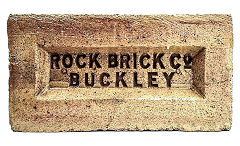
'Rock Brick Co Buckley'
|
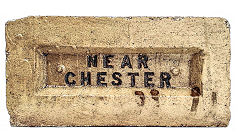
'Near Chester'
|
|
|
Spon Green, Buckley (51) - SJ 2882 6360
Began in 1858, the Spon Green Colliery was producing bricks by 1862 but ceased production during the period 1871-1875.
Trap, Buckley (35) - SJ 2783 6531
The oldest brickworks in North Wales was begun by Jonathan Catherall, possibly as early as 1737. His grandson, also Jonathan, took over the company in 1777 until 1792 when he went to Ewloe Place and his brother, John, carried on with Trap until he died in 1805. The works appears to have been closed from 1805 until 1842 when it re-opened as the 'Ewloe Brick & Tile Co' or 'Ewloe Brickworks Co'. The Catherall family became involved as partners from 1865 to 1880 when they took full ownership again. The works was sold to the Castle Firebrick Co in 1936, refurbishing it in 1962 but selling it on to the 'Butterley Building Co' in 1972 until its closure in 1985.

Trap Brickworks, 1900
|
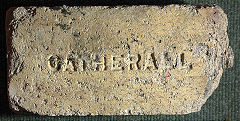
'Catherall'
|
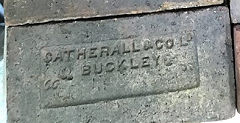
'Catherall & Co Ld Buckley'
|

'Catherall & Co Ld Buckley'
|
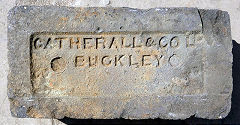
'Catherall & Co Ld Buckley'
|

'Catherall & Co Buckley Flintshire'
|
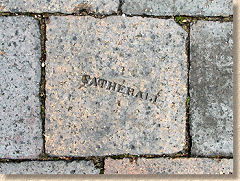
'Catherall' paver
|
|
Mold (West of Buckley)
Alltami Kiln, Mold (22) - SJ 2674 6549
A railway map of 1865 shows this kiln and there's a brief mention of a kiln in Alltami in 1882.
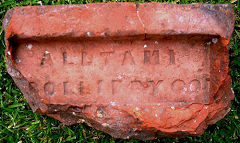
'Alltami Colliery Co'
|
|
|
Broncoed Colliery, Mold (26) - SJ 2390 6225
First mentioned in 1848, Brincoed Colliery had its own brickfield in 1861, if not earlier. The site is marked 'old colliery' by 1878.
Colomendy brickworks and Tydden Tilery, Mold (24) - SJ 2523 6307
As a tilery the site was in use from 1847 making items for drainage. An advert for a brickmaker appeared in 1854 issued by the 'Tydden Brick & Tile Works'. It appears to have become the 'Colomendy Brick, Tile & Clay Co'. It appears to have closed in 1884 and referred to as 'old brickworks' in 1899.

'Colomendy Co Mold'
|
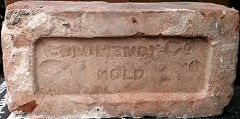
'Colomendy Co Mold'
|

'Colomendy BT&CCo Mold'
|
Gwernymynydd, near Mold (28) - SJ 2123 6239
In 1872 a tramway ran from claypits at SJ 2028 6197 ending at Aberduna Farm, near a wood named 'Brick Kiln Plantation'. By 1899 the tramway extended to the Cambrian Fire Clay Co's brickworks in Gwernymynydd. By 1901 the works were dormant and up for sale. By 1912 the tramway had disappeared and the works was the property of the Cambrian Mining Co after which nothing more is known. The works was still shown on the 1938 OS map but gone by 1948.
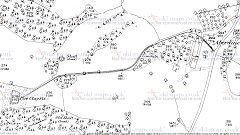
Aberduna tramway, 1872
|
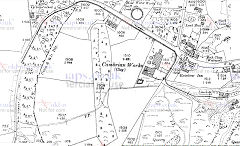
Cambrian Brickworks, 1899
|

Cambrian Brickworks, 1910
|

Cambrian Brickworks, c1900
|
Mold Argoed Colliery, Mold (23) - SJ 2471 6403
The Argoed Colliery Co came into being in 1863 and almost certainly making bricks. By 1868 it was the 'Argoed Hall Colliery, Brick, & Tile Co and in 1874 an improved brickworks was built. This new brickworks were soon advertising 150,000 bricks for sale. The company went into liquidation in 1880 but despite a new owner it closed in 1886.

'Mold Argoed Colliery'
|
|
|
New Brighton brickfield, Mold (21) - SJ 2540 6537
A small site recorded between 1868 and 1882, run by Edward Jones and later by Edward Melling.
New Brighton Colliery, Mold (20) - SJ 2526 6568
Mapped in 1871 and auctioned in 1877, the colliery and its brickworks are shown as 'disused' by 1900.
Oak Pits Colliery, Mold (25) - SJ 2395 6262
Oak Pits was sunk in 1858, becoming the 'Welsh Coal, Mineral & Oil Co in 1863. By 1879 it was the 'Oak Pits Colliery Co' only for it to be sold in 1881 and closed in 1887 due to flooding. Brick kilns are shown on the 1871 OS map.
Old Fferme Colliery, Mold (19) - SJ 2507 6583
In existance by 1857 but unrecorded until 1889 by the 'Twn Tyll Co', becoming known as 'Old Ferme' by 1893. A report of 1894 refers to its 'good common bricks' but the company went into receivership the same year and the site was probably abandoned.
Ruby brickworks, Rhydymwyn, Mold (27) - SJ 2051 6773
Coal and clay were mined here from 1867 but the clay was just stockpiled so, in 1892, the 'North Wales Brick and Tile Co Ltd' opened a brickworks. It became the 'Ruby Brick and Tile Co Ltd' in 1898 and continued in production until 1965, even though the 1948 map shows it as 'disused'. The works lay derelict until 2003 when demolition began. Luckily Paul Dobson recorded the site before it disappeared.

Ruby Brickworks in 1898
|

Ruby Brickworks in 1910
|
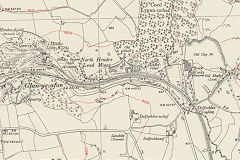
Ruby Brickworks in 1948
|
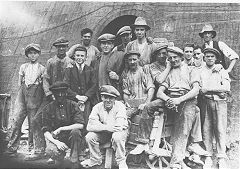
Workers at the Ruby Brickworks
|
The Derelict Brickworks
Paul Dobson took these photos of the Ruby Brickworks lying derelict between 1965 to 2003
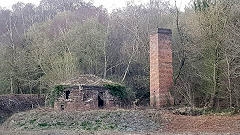
Ruby Brickworks, Rhydymywn
|
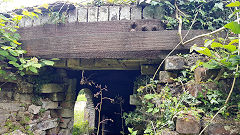
Ruby Brickworks, Rhydymywn
|
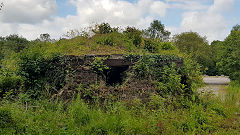
Ruby Brickworks, Rhydymywn
|

Ruby Brickworks, Rhydymywn
|

Ruby Brickworks, Rhydymywn
|
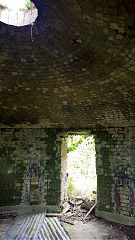
Ruby Brickworks, Rhydymywn
|
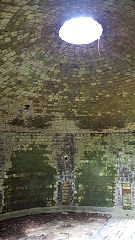
Ruby Brickworks, Rhydymywn
|

Ruby Brickworks, Rhydymywn
|
The Brickworks Products

'Ruby Brickworks Rhyd y Mywn'
|
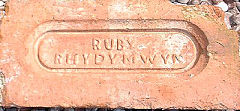
'Ruby Rhydymywn'
|
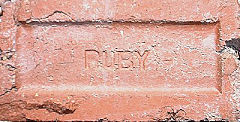
'Ruby'
|
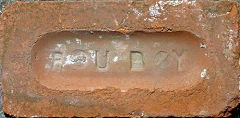
'Ruby'
|
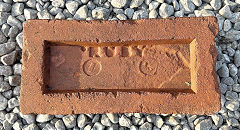
'Ruby'
|
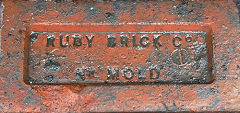
'Ruby Brick Co Nr Mold'
|
|
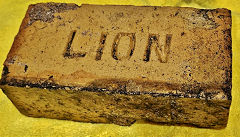
'Lion' possibly from the Ruby brickworks
|
Northern Flint
Connahs Quay
Connah's Quay had four, if not five, brickworks within a few yards of each other, just off the High Street.
Prince's Brickworks, Connahs Quay (10) - SJ 2935 6926
James Prince opened his brickworks c1879 which remained a family business until the works closed in 1961. It was managed by James son John, his grandson Sidney and finally his great grandson John L Prince. The photos of Prince's products below have been kindly supplied by members of the Prince family who have kept them as mementos of the company.
Andrew Reney, Connahs Quay (7) - SJ 2936 6963
Possibly the oldest brickworks, as a brickyard is shown in 1870 at SJ 2970 6958 and may be Reney's very first venture. This site was disused by 1910 with most of the buildings demolished. The clayhole was filled in 1951
Thomas Reney, Connahs Quay (8) - SJ 2930 6955
Ths works appears to have been founded by W H Lloyd in c1890. He became indebted to T J Reney who took over the works which closed c1916. The clayhole was filled in 1967.
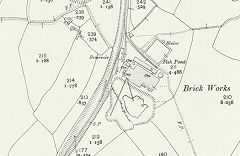
Prince's Brickworks, 1910
|
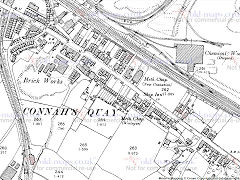
Reney's original brickworks, 1910
|
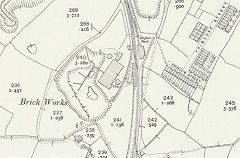
Reney's new brickworks, 1910
|
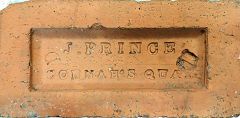
'J Prince Connahs Quay', type 1
|
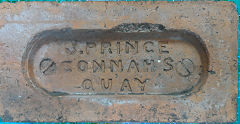
'J Prince Connah's Quay', type 2
|

'J Prince Connah's Quay', type 2
|

'J Prince Connan's Quay', mis-spelt
|
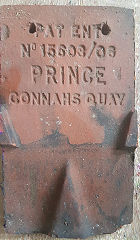
'Prince Connahs Quay'
|
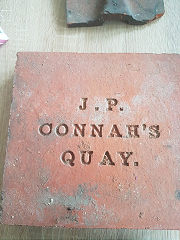
'J. P. Connah's Quay'
|
John Williams, Connahs Quay (9) - SJ 2926 6968
John Williams brickworks was in production by 1881. He died in 1900 and the works appears to be disused n c1912. By the late 1930s Alun Edwards was running it but it had closed by the early 1950s.
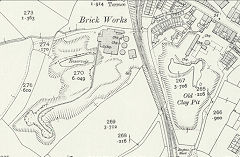
Williams Brickworks, 1910
|
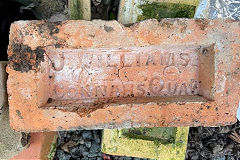
'J. Williams Connahs Quay'
|
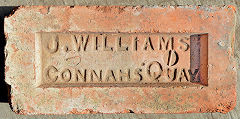
'J. Williams Connahs Quay'
|
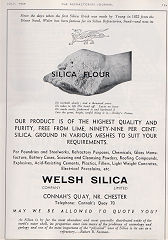
'Welsh Silica Co Ltd' advert
|
Flint
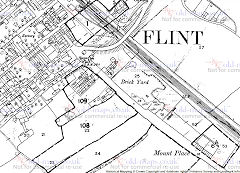
Bath Colliery brickworks, 1871
|

Pentre brickyard, Flint, 1871
|
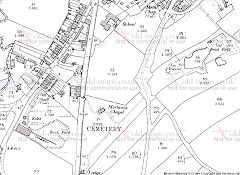
Flint Brick & Tile Works, 1899
|

Flint Brick & Tile Works, 1912
|
Bath Colliery, Flint (2) - SJ 2475 7288
A short-lived brickworks owned by Edward Bower in production from c1859 to c1883
Flint Brick and Tile Co, Flint (3, 4) - SJ 2406 7263
Probably on the site of the Eyton familys brick kiln of the 1840s, Peter Bibby opened a brick works in 1873 on land owned by Adam Eyton. By 1895 the works was in the possession of 'Birks and Jones' and in 1913, 'Jones and Davies'. The works appears to have closed and demolished some time after 1924.

Flint Brick & Tile Co advert
|

Flint Brick & Tile Co advert
|
|
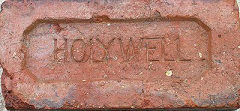
'Holywell'
|
Jacob Davies brickworks, Flint (6) - SJ 2442 7276
Jacob Davies, a brickmaker from Ruthin, started this works in 1872 and it was purchased by the Flint Brick & Tile Co in 1879. However the site is marked as an 'old brick field' by 1899.
Northop Road brick kiln, Flint (5) - SJ 2416 7248
A brickyard existed on the corner of Northrop Road and Coed Onn Road in the 1850s but there is no trace of it on the 1871 OS map.
Pentre brickyard, Flint (1) - SJ 2509 7275
Another small brickyard possibly operating in the 1850s but more certanly for a few years around 1873, owned by a William Pierce. By 1899 the site is marked as an 'old brick kiln'.
Mostyn
Mostyn was the home to one sizeable brickworks and at least one old brick kiln but this area isn't covered in Andrew Conolly's book.
Mostyn brickworks, Mostyn - SJ 1710 7940
This brickworks was advertising its wares in 1905 and is first shown on the 1912 OS map. It's on the 1949 map but had gone by 1963.
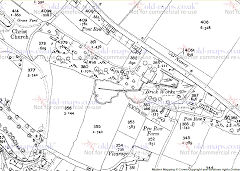
Mostyn Brickworks, 1912
|
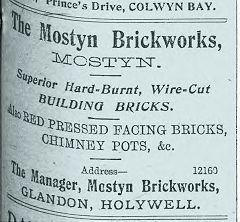
Mostyn Brickworks advert, 1905
|
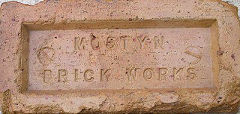
'Mostyn Brickworks'
|
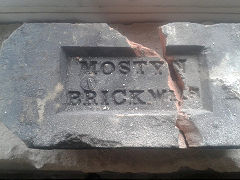
'Mostyn Brickwks'
|
Trelogon brick kiln, near Mostyn - SJ 1210 8052
A brick kiln is shown on the 1872 OS map but had gone by 1899. it was probably connected with the adjacent lead mine.
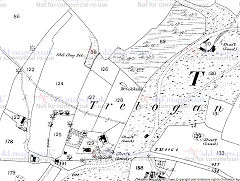
Trelogon brick kiln, 1872
|
|
|
Queensferry
Aston Brickworks, Queensferry (15) - SJ 3150 6720
The only pure brickworks in Queensferry, unconnected to a colliery. It was working in 1861 and continued as a medium-sized works until 1916, after which it disappears from records.
Eleanor Colliery, Queensferry (13) - SJ 3110 6847
This colliery was established in 1867-8 and probably mainly made bricks for their own use and closed after 1881.
Great Mancot Main Collery, Queensferry (16) - SJ 3195 6725
A short-lived colliery and brickworks, only working from 1861 to 1867.
Mancot Bank Colliery, Queensferry (17) - SJ 3204 6642
Founded in 1856, the 'Mancot Bank Colliery & Brickworks' survived only until 1871. A 'brick kiln field' is shown nearby on the 1840 Tithe Map.
Queensferry Colliery, Queensferry (14) - SJ 3175 6773
The 1840 Tithe Map shows 'coal pit fields' here becoming a more permanent colliery in 1856. A brickworks is mentioned with the colliery in 1863. The colliery was acquired by the 'Aston Hall Colliery Co' in 1878. Despite plans for a new brickworks here, the assets were sold off in 1913 but no brickmaking equipment is mentioned.
Rake Collery, Queensferry (18) - SJ 3325 6565
Rake Colliery appears to have had a small brickworks from c1860 to 1870. The 1840s tithe map also shows an older 'brickfield' at SJ 3340 6580.
Shotton
Rowley's Brickworks, Shotton (12) - SJ 3065 6832
Rowley's Brickworks was founded c1898 by Henry Butler Rowley as the Shotton Lane Brickwork Co. He tried unsuccessfully to sell the works one year later and then put it up for auction in 1919. It is last recorded as owned by William Astbury in the 1930s.
Wepre Hall, Shotton (11) - SJ 3036 6837
Built on the Wepre Hall Estate in 1899, the Wepre Hall Brick Co Ltd premises continued working until at least 1978. In 1949 it was sold ot Fred Jones, who also owned Lane End Brickworks in Buckley.
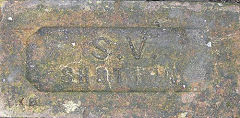
'S V Shotton'
|
|
|
South-Western Flint
Coed Talon, Alyn (62) - SJ 2672 5868
Originally the 'Gem Brick Tile & Terra Cotta Co', registered in 1896, until taken over by the 'Alyn Brick Tile & Terra Cotta Co' in 1901 but still using the 'Gem' trade mark.
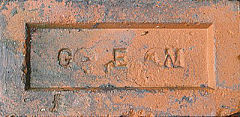
'Gem'
|
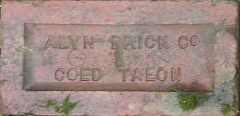
'Alyn Brick Co Coed Talon'
|

'Alyn Brick Tile & Terra Cotta Co'
|
Coed Talon, Plas Yn Mhocwys (63) - SJ 2635 5965
First recorded in 1864 as a 'field brickyard', becoming a larger concern by 1867. It was not listed in the rates book by 1898.
Frith, The Ford Artificial Stone Works (66) - SJ 2810 5614
Not a clay brickworks as such but the only artificial stone works in Flintshire, operating from 1899 to 1916.
Hope, Caer Estyn (58) - SJ 3211 5762
A brickworks was built here between 1864 and 1872. In 1914 a company called 'Caergwrle Plastic Brick & Tile Co' may have have been here. The site was in ruins in the 1930s.
Hope, Caer Estyn (R Williams) (59) - SJ 3187 5751
Close to the other Caer Estyn works, Richard Williams was running a brickworks in 1864 according to a railway map. It is described as 'old brickyard' in the 1870s and was demolished after 1879.
Hope, Golley (or Golly), (Actually in Denbighshire) (67) - SJ 3360 5842
A small rural brickworks is shown close to Golley Farm in 1871 and 1881 but it had gone by 1891, It was operated by William Davies and then William Kendrick.
Hope, Higher Kinnerton (54) - SJ 3120 6245
The Higher Kinnerton Brick and Tile Co were operating here by 1859. In 1871 it had 3 kilns but by 1910 it was disused and was labelled 'worked-out clayhole' in 1912.
Hope Hall Estate, Hope (57) - SJ 3155 5842
This estate brickworks was unusual in that its bricks were machine-made and imprinted with its name. A sale plan of Hope Hall mentions a claypit in 1912 but little else is known.
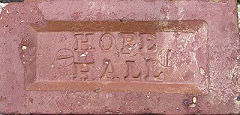
'Hope Hall'
|
|
|
Hope Tilery, Hope (56) - SJ 3124 5934
This tilery was for sale in 1855 and is marked as a brickworks on the 1871 OS Map. It was mentioned in the sale of Rhyddon Hall Estate in 1875 but then disappears.
Hope, Nercwys (60) - SJ 2271 6164
Nercwys Cambrian Fireclay Works was working in 1874 but was in liquidation in 1876 and had gone by 1900.
Hope, Penyffordd (55) - SJ 3075 6159
Penyffordd was home to a small brickyard in the 1870s only. Next door was 'Hope Oil Works' which may also have had a brick kiln at the same time, possibly the two sites worked together.
Llanfynydd (65) - Uncertain location, possibly SJ 2751 5658
Reported to have been built in 1898, this works only lasted a few years, possibly as the 'Hafod Abley Brick Co' by 1903 but nothing else is known.
Pontybodkin, Erith (61) - SJ 2708 5940
The 'London Leeswood & Erith Oil Mineral Co' were treating thier workers at the 'Pontblyddyn Oil & Coal Works' in 1867 but appears to have closed by 1870. It had re-opened by 1899, trading as the 'Erith Brick, Tile & Terracotta Co' or the 'Erith Blue Brick Co'. Following further changes in ownership, the works closed in the 1970s.
Pontybodkin, Leeswood Green (64) - SJ 2675 5939
Leeswood Green Colliery was founded c1857 and brickmaking had commenced by 1862. The ownership of the colliery and brickworks is quite obscure but by 1891 Pontybodkin Brickworks appears to be a separate venture from the colliery. It was for sale in 1925 and nothing is known after this.
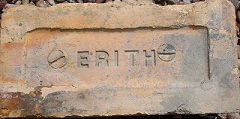
'Erith'
|
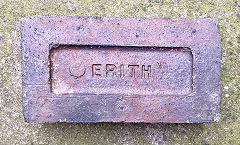
'Erith'
|
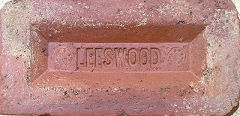
'Leeswood'
|
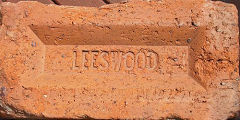
'Leeswood'
|
Unknown Brickworks
'Flintic' bricks
Bricks marked 'Flintic' are to be found in the area and I assume that 'Flintic' is a trademark that relates to Flintshire. If you know anything more, please let me know too.
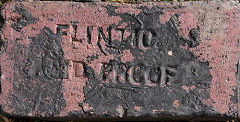
''Flintic Acid Proof'
|
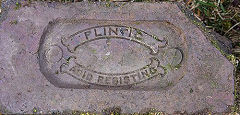
''Flintic Acid Resisting'
|
|
Acknowledgments, sources and further reading.
A great many people have supplied information and photos to add to the story, so many thanks to (alphabetically) David Bell, Graham Bennett, Mike Bennett, Steve Berden, Peter Borgs, Lyn Bostock, Wayne Broadhurst, John Bromley, Phil Burgoyne, Sam Burrows, Sean Claverey, Ian Cooke, Mark Cranston, Gary Davies, Steve Davies, Paul Dobson, Hamish Fenton, Russ Firth, Fluffy5518, Leslie Francis, Martyn Fretwell, Tony Gavin, Ken Griffths, Andrew Harvard, Tracey Hucker, Stuart Hughes, Catherine James, Glen Johnson, Kes Jones, Mike Kilner, David Kitching, Frank Lawson, Henry Lisowski, Norman Lowe, Steve Milner, Frank Moore, Stephen Parry, Richard Paterson, Ken Perkins, Ian Pickford, Kevin Prince, Eileen Ellis Pritchard, Phil Pritchard, Glyn Roberts, Dave Sallery, Lawrence Skuse, Ian Sneyd, Jason Stott, Ian Suddaby, Eric Taylor, Gareth Thomas, David Wood, D Wright amonst many others.
A suberb book entitled 'Life in the Victorian brickworks of Flintshire and Denbighshire', written by Andrew Connolly, has a vast amount of information on the bricks and brickworks along with chapters on the brickmaking process itself. There are nearly 300 large pages of text, photos and maps and it is available from the usual bookseller websites.
Messrs Sallery and Kitchings 'Old Bricks' website is the best source of info on bricks and brickworks in the UK :-
Old Bricks - history at your feet. Denbighshire and Flintshire are extremely well covered by individual pages on 'Old Bricks', which are linked below.
For very good coverage of Scottish bricks and quite a bit about other places too :-
Scottishbrickhistory.co.uk
Martyn Feltwell has two very good sites here :-
East Midlands Named Bricks and
UK Named Bricks
There is a specialist society for brick history :-
britishbricksoc.co.uk
There's also a 'Facebook' group for bricks and brickworks :-
Facebook 'Bricks and Brickworks past' group
A Guide to the Website
Industrial Wales
Collieries, Ironworks, Quarries, Railways, Canals, Tramroads, Tunnels, Culverts and so much more....
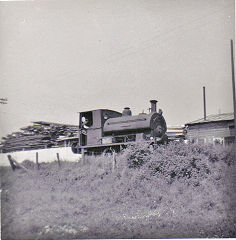
|
Brickworks of Wales
Bricks are 'History with a label' so here's the story of the Brickworks of Wales - photos, maps and the products themselves
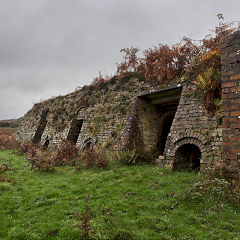
|
Around the World
My travels around the UK and the Whole Wide World in search of industries, railways, trams and mines to name a few.
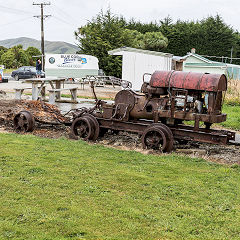
|
Boundary Stones and Mileposts
Boundary Stones, Mileposts and other markers in simple alphabetical order of their initials, name or site.

|
Ships and Shipping
Ships around the World in simple alphabetical order of their name (or apparent area if I can't read the name).

|
The Site Map and Index
A full list of all the pages of the whole website in just one place, so you should find exactly what you are looking for.

|
About the Site
The background and technical details about the site, plus a contact page and links to other sites - and a warning !!
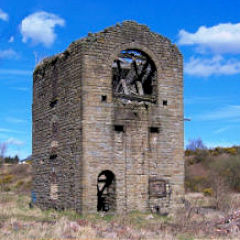
|
Contact Me
Something to add? A great photo? Something wrong? or need to know more about things? Just drop me a line here.

|
Further Reading
You can find lots of local and other very helpful websites, books, magazines and Facebook groups all listed here.
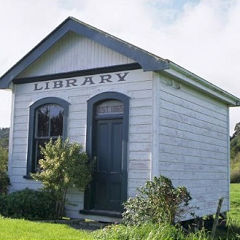
|
All rights reserved - Phil Jenkins





















































































